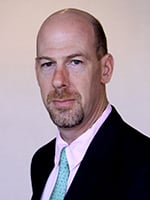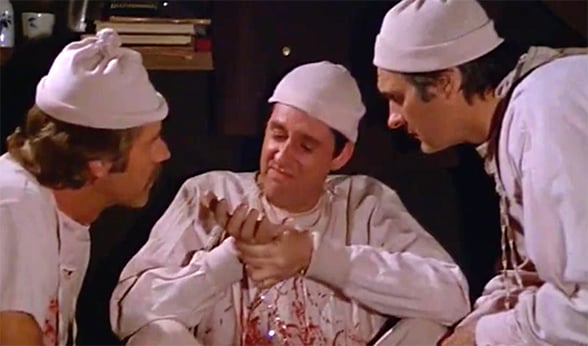When Marc Moss, MD, vice chair of clinical research for the Department of Medicine at the University of Colorado School of Medicine (SOM), delivers presentations about the growing epidemic of physician burnout he shows a clip from the “M*A*S*H” TV show. In the “Heal Thyself” episode, the Army hospital hosts a top-notch replacement surgeon who ends up breaking down amid the unabated stream of wounded soldiers. The strain builds until the surgeon finally crumples to the floor, rubbing his hands together and saying to no in particular, “The blood won’t come off.”

Marc Moss, MD, vice chair of clinical research for the Department of Medicine
Likewise, the real-world working environments for critical care professionals — stress-filled, with high rates of morbidity and mortality — can cause severe psychological distress. “We see a lot of tragedy in the ICU, and no one ever taught us to deal with this,” Moss said. “It’s all pretty similar to what occurred in a war setting. … The wellness of healthcare professionals is the next big issue in health care.”
A first for university
Enhancing wellness and preventing burnout among healthcare professionals, especially critical care providers, is a strong area of interest for Moss, who is also the Roger S. Mitchell professor of medicine in the Division of Pulmonary Sciences and Critical Care Medicine. Last summer, he applied for a cooperative agreement from the National Endowment for the Arts (NEA), which recently awarded $150,000 to CU to create a Creative Arts Therapy (CAT) program for critical care professionals. With additional matching funds from the Department of Medicine and the Division of Pulmonary Sciences and Critical Care Medicine, the full amount of the award is $375,000.
It is the first NEA award of its kind to the University of Colorado Denver | Anschutz Medical Campus, according to the Office of Grants & Contracts. The idea is to establish CAT programs in writing, visual arts, music and dance to help critical care providers connect to the purpose of their work, develop coping skills and provide time to reflect and connect with their peers.

This scene from the TV show "M*A*S*H" features prominently in Marc Moss' presentations about the growing epidemic of physician burnout.
The long-term goal is to create a hub of creative outlets that help professionals better cope with the stressful aspects of their work.
Alarming burnout rates
The National Academy of Medicine recently recognized that “The people we rely on to keep us healthy may not be healthy themselves.” The un-wellness trends in the profession are alarming:
- Over half of doctors feel their families have suffered from their choice of becoming a physician.
- A 2014 national survey found that 54 percent of U.S. physicians reported at least one symptom of burnout.
- Physicians have double the suicide rate of the general population.
- Growing rates of depression and substance abuse.
Burnout in the health care field, which is seeing a workforce shortage amid increasing clerical burdens and pressure to reduce costs, is “really common and has devastating consequences,” Moss said. “It affects patient care, providers’ health and has economic implications.”
Other factors causing stress among health care professionals include:
- Less autonomy at work (more focus on documentation, and increased shift work);
- Patients are sicker (more chronic diseases and critical illnesses);
- Increased patient/family expectations; and
- Decreased patient trust (in 1966, 73 percent of Americans had great confidence in the medical profession; in 2012, the rate declined to 34 percent).
Trifold goals
Research shows that health care professionals with burnout syndrome (BOS) are more likely to leave the profession, resulting in turnover that drives up health care costs, reduces quality of care, and diminishes staff morale. Through the arts interventions, the CU research group hopes to:
- Reverse the trend of BOS and other forms of psychological distress in critical care providers;
- Improve patient care by addressing the well-being of health care providers; and
- Reduce costs by reversing the high rates of turnover.
In the next two years, CU will design four CAT programs for 150 critical care providers and test their feasibility, acceptability and effectiveness. The Division of Pulmonary Sciences and Critical Care Medicine has a strong history of studying this issue; CU’s critical care research group is one of only two U.S. groups that are funded by the National Institutes of Health to study burnout syndrome in health care providers.
‘We’re supposed to be tough enough to do this kind of work. There is a stigma; it needs to change.’ – Marc Moss, MD
In the NEA initiative, the CU research group is one of four grant awardees in the third cohort. There are two previous cohorts of four awards each, for a total of 12 awards.
Partnering with nonprofits
For the writing CAT, Moss’s group will partner with the Lighthouse Writers Workshop, which engages with many different populations, including cancer patients and at-risk youths, to use creative writing as an emotional and relaxational outlet. For the visual arts, music and dance/movement CAT, CU will partner with the Ponzio Creative Arts Therapy Program which serves children and adolescents at the Pediatric Mental Health Institute of Children’s Hospital Colorado.
A fifth area of therapy, horticultural activity in conjunction with the Denver Botanic Gardens, is also being considered.
A major aspect of the problem, Moss said, is the stigma associated with admitting to the difficulty of maintaining personal wellness as a healthcare professional. “We’re supposed to be tough enough to do this kind of work without suffering from mental stress,” he said. Studies have shown that health care professionals are reluctant to share these problems because they’re worried about how it reflects on their medical center or may impact career advancement. “If anything, these symptoms of burnout appear in the most ideal of employees,” Moss said. “They occur in people you’d want to have as your doctor or nurse. There is a stigma; it needs to change.”
Programs to replicate nationally
While the research project hopes to demonstrate how these creative outlets can reduce burnout and restore joy to health care providers in the Denver area, the goal is to reach a broad population of professionals, Moss said. Emerging best practices could be replicated to health care workers, who work in both critical and non-critical positions, nationwide.
“The goal will be to develop these programs and disseminate them across the country,” he said.




